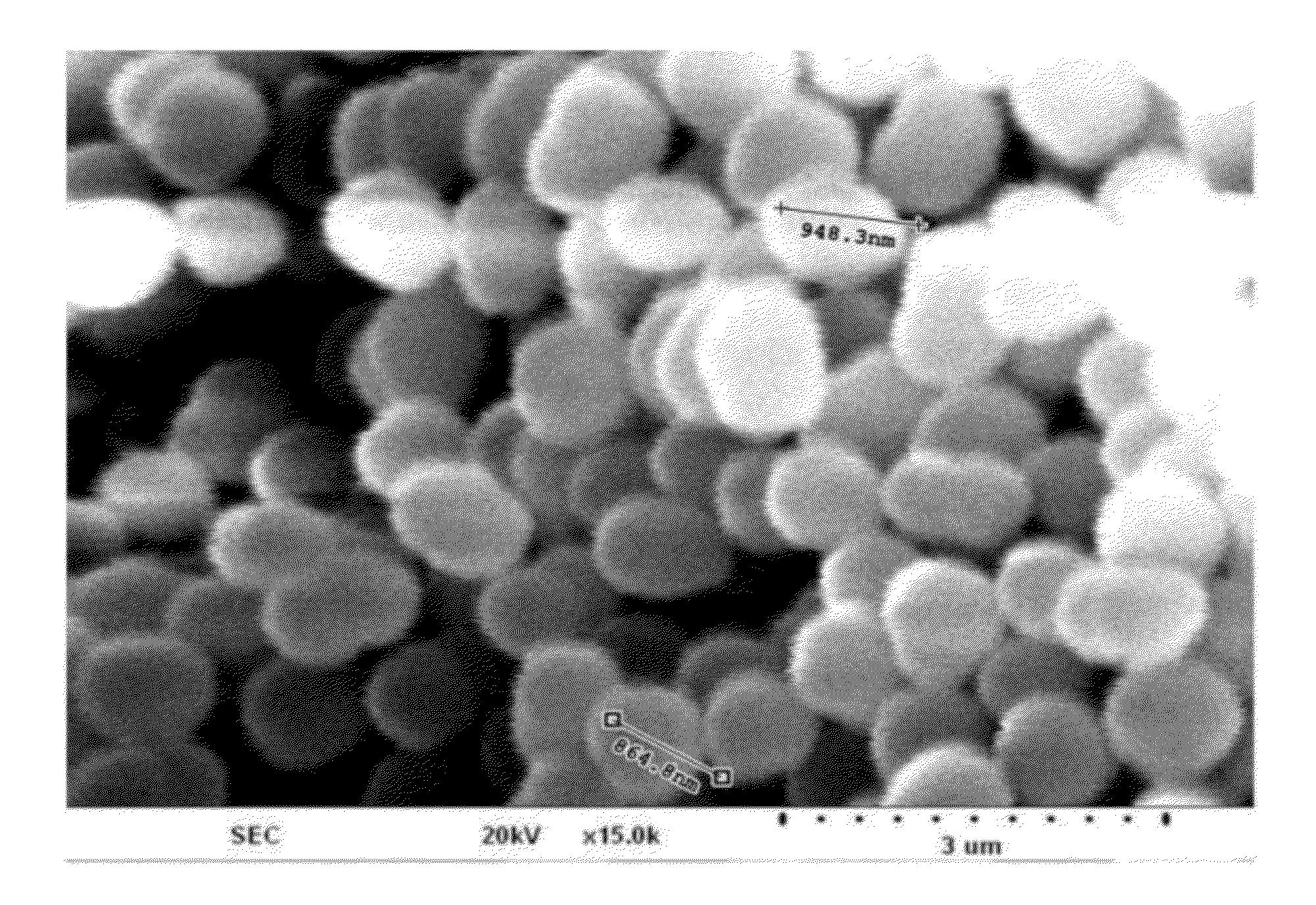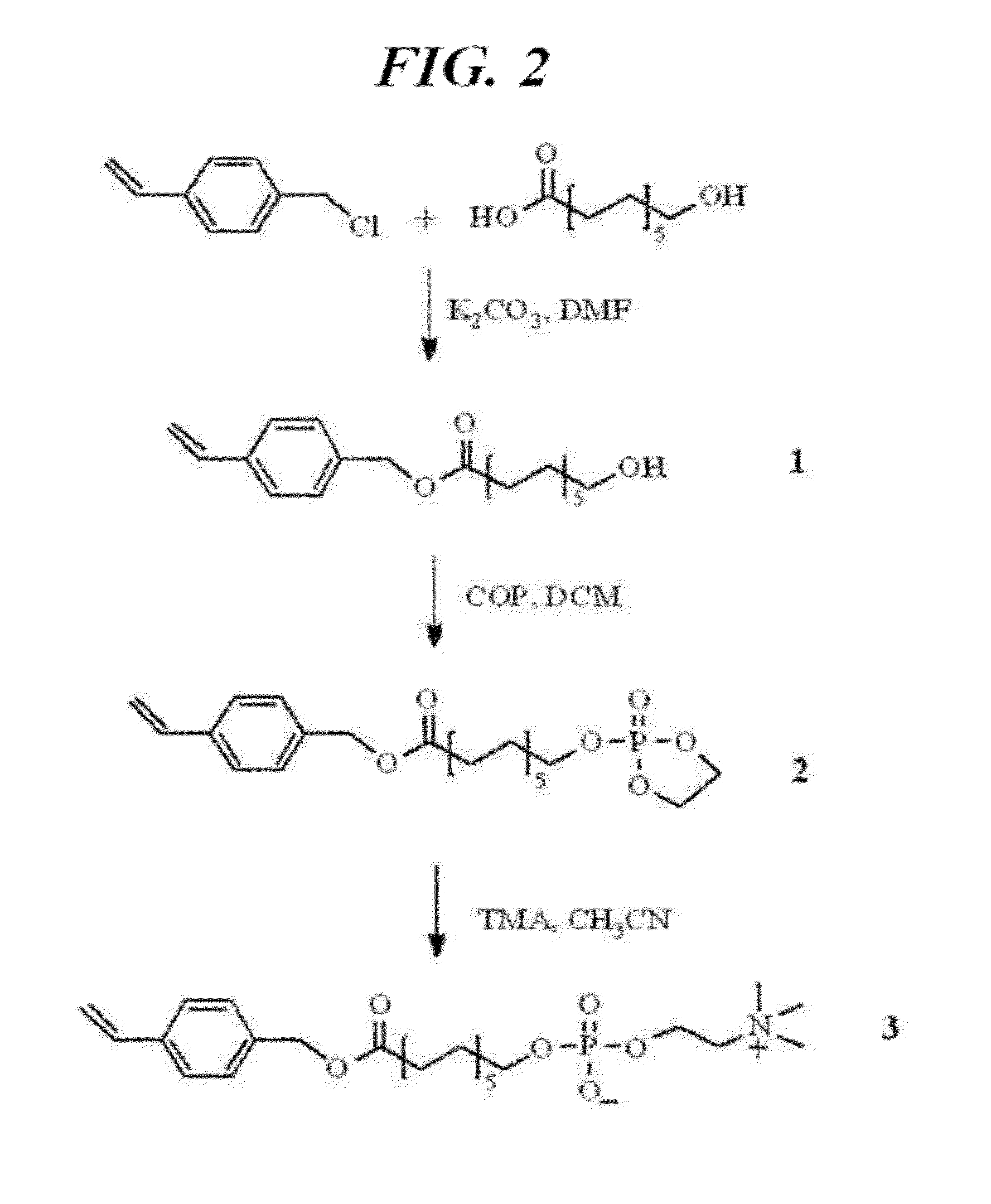Molecularly printed polymer for detecting the pentraxin, and method for preparing same
a technology of molecular imprinting and pentraxin, which is applied in the field of molecular imprinting structure for detection of pentraxin protein and a method for preparing same, can solve the problem of high cost of preparing antibody, and achieve the effects of improving detection effect, fast and effective, and high constant for binding
- Summary
- Abstract
- Description
- Claims
- Application Information
AI Technical Summary
Benefits of technology
Problems solved by technology
Method used
Image
Examples
example 1
Preparation of a Styrene-Phosphocholine Ligand
[0077]A process for preparing a styrene-phosphocholine ligand was described below with reference to FIG. 2. The products presented in FIG. 2 have been identified through NMR.
[0078]12-hydroxydecanoic acid and potassium carbonate were added into 100 ml of N,N′-dimethylformamide and stirred at a room temperature for about 10 minutes. Thereafter, 4-vinylbenzyl chloride was added thereinto and stirred while being heated at less than about 80° C. After the reaction was finished, N,N′-dimethylformamide was removed through distillation under reduced pressure. The reacting material was dissolved in dichloromethane and then washed with water. Dichloromethane layers were collected and dried with a magnesium sulfate. From the dried dichloromethane, the magnesium sulfate was removed by a depressurization filter, and dichloromethane was removed through distillation under reduced pressure. Thereafter, column chromatography purification using an eluent ...
example 2
Preparation of a Polystyrene Film, in which a Styrene-Phophocholine Ligand is Molecularly Imprinted
[0090]A method for preparing a molecularly imprinted polymer according to an illustrative embodiment is described below with reference to FIG. 5.
[0091]Total 1 ml of styrene / DVB(divinylbenzene) as a crosslink agent, and DBK(dibenzylketone) as an initiator, were added to 10 ml of a standard phosphate buffer solution (pH 7.0) with a ratio of styrene:DVB:DBK=9:1:1. Thereafter, a C-reactive protein and a styrene-phosphocholine ligand, which have been reacted together in advance, were added thereto with a molar ratio of 1:5. Since the C-reactive protein and the styrene-phosphocholine ligand were strongly bound to each other via calcium ions, they have been reacted in advance in a binding buffer solution (0.1M Tris, 5 mM CaCl2, 150 mM NaCl, and pH 8.0) thereby inducing photo-polymerization thereafter. With respect to conditions for the polymerization reaction, photo-polymerization was perform...
experimental example 1
Measurement of a Binding Force of a C-Reactive Protein to a Molecularly Imprinted Polymer
[0092]A binding force of a C-reactive protein to a molecularly imprinted polymer was analyzed by detecting a C-reactive protein through the Bradford assay method and an immunoassay method. In this case, in addition to a molecularly imprinted polymer (MIP), a molecularly non-imprinted polymer (NIP) and a polystyrene polymer (control polymer; CP) were prepared to analyze a molecularly imprinting effect. The molecularly non-imprinted polymer was prepared by using a reactive ligand without molecularly imprinting of CRP. The polystyrene polymer was prepared without using a reactive ligand and CRP.
[0093](1) Bradford Assay Method
[0094]5 μg of a CRP was added to the prepared molecularly imprinted polymer and reacted at 0° C. for 30 minutes. In order to remove a non-specifically bound protein, the reacting material was washed three times with PBS or repeatedly washed three times with a TBST buffer soluti...
PUM
| Property | Measurement | Unit |
|---|---|---|
| length | aaaaa | aaaaa |
| length | aaaaa | aaaaa |
| height | aaaaa | aaaaa |
Abstract
Description
Claims
Application Information
 Login to View More
Login to View More - R&D
- Intellectual Property
- Life Sciences
- Materials
- Tech Scout
- Unparalleled Data Quality
- Higher Quality Content
- 60% Fewer Hallucinations
Browse by: Latest US Patents, China's latest patents, Technical Efficacy Thesaurus, Application Domain, Technology Topic, Popular Technical Reports.
© 2025 PatSnap. All rights reserved.Legal|Privacy policy|Modern Slavery Act Transparency Statement|Sitemap|About US| Contact US: help@patsnap.com



